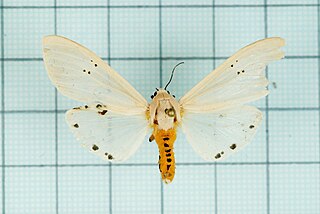Related Research Articles

The Arctiinae are a large and diverse subfamily of moths with around 11,000 species found all over the world, including 6,000 neotropical species. This subfamily includes the groups commonly known as tiger moths, which usually have bright colours, footmen, which are usually much drabber, lichen moths, and wasp moths. Many species have "hairy" caterpillars that are popularly known as woolly bears or woolly worms. The scientific name Arctiinae refers to this hairiness. Some species within the Arctiinae have the word "tussock"' in their common names because they have been misidentified as members of the Lymantriinae subfamily based on the characteristics of the larvae.
Chemical ecology is the study of chemically-mediated interactions between living organisms, and the effects of those interactions on the demography, behavior and ultimately evolution of the organisms involved. It is thus a vast and highly interdisciplinary field. Chemical ecologists seek to identify the specific molecules that function as signals mediating community or ecosystem processes and to understand the evolution of these signals. The substances that serve in such roles are typically small, readily-diffusible organic molecules, but can also include larger molecules and small peptides.

Carminic acid (C22H20O13) is a red glucosidal hydroxyanthrapurin that occurs naturally in some scale insects, such as the cochineal, Armenian cochineal, and Polish cochineal. The insects produce the acid as a deterrent to predators. An aluminum salt of carminic acid is the coloring agent in carmine, a pigment. Natives of Peru had been producing cochineal dyes for textiles since at least 700 CE. Synonyms are C.I. 75470 and C.I. Natural Red 4.

Greta oto is a species of brush-footed butterfly and member of the subfamily Danainae, tribe Ithomiini, and subtribe Godyridina. It is known by the common name glasswing butterfly for its transparent wings, which allow it to camouflage without extensive coloration. In Spanish speaking regions, it may also be referred to as espejitos, meaning "little mirrors" because of its transparent wings. The butterfly is mainly found in Central and northern regions of South America with sightings as far north as Texas and as far south as Chile. While its wings appear delicate, the butterfly is able to carry up to 40 times its own weight. In addition to its wing physiology, the butterfly is known for behaviors such as long migrations and lekking. The Greta oto closely resembles the Greta andromica.

The queen butterfly is a North and South American butterfly in the family Nymphalidae with a wingspan of 80–85 mm (3.1–3.3 in). It is orange or brown with black wing borders and small white forewing spots on its dorsal wing surface, and reddish ventral wing surface fairly similar to the dorsal surface. The ventral hindwings have black veins and small white spots in a black border. The male has a black androconial scent patch on its dorsal hindwings. It can be found in meadows, fields, marshes, deserts, and at the edges of forests.

Utetheisa is a genus of tiger moths in the family Erebidae. The genus was first described by Jacob Hübner in 1819.

The garden tiger moth or great tiger moth is a moth of the family Erebidae. Arctia caja is a northern species found in the US, Canada, and Europe. The moth prefers cold climates with temperate seasonality, as the larvae overwinter, and preferentially chooses host plants that produce pyrrolizidine alkaloids. However, garden tiger moths are generalists, and will pick many different plants to use as larval host plants.

Halysidota tessellaris, also called the pale tiger moth, banded tussock moth, and tessellated halisidota, is in the family Erebidae and the tribe Arctiini, the tiger moths. The species was first described by James Edward Smith in 1797. Like many related species, adult moths have chemical defenses acquired from its host plants, in this case, alkaloids. Larval behaviors suggest that they are chemically protected; they have not been analyzed for alkaloid content.

Pyrrolizidine alkaloids (PAs), sometimes referred to as necine bases, are a group of naturally occurring alkaloids based on the structure of pyrrolizidine. Pyrrolizidine alkaloids are produced by plants as a defense mechanism against insect herbivores. More than 660 PAs and PA N-oxides have been identified in over 6,000 plants, and about half of them exhibit hepatotoxicity. They are found frequently in plants in the Boraginaceae, Asteraceae, Orchidaceae and Fabaceae families; less frequently in the Convolvulaceae and Poaceae, and in at least one species in the Lamiaceae. It has been estimated that 3% of the world’s flowering plants contain pyrrolizidine alkaloids. Honey can contain pyrrolizidine alkaloids, as can grains, milk, offal and eggs. To date (2011), there is no international regulation of PAs in food, unlike those for herbs and medicines.
Sex pheromones are pheromones released by an organism to attract an individual of the same species, encourage them to mate with them, or perform some other function closely related with sexual reproduction. Sex pheromones specifically focus on indicating females for breeding, attracting the opposite sex, and conveying information on species, age, sex and genotype. Non-volatile pheromones, or cuticular contact pheromones, are more closely related to social insects as they are usually detected by direct contact with chemoreceptors on the antennae or feet of insects.

Ithomiini is a butterfly tribe in the nymphalid subfamily Danainae. It is sometimes referred to as the tribe of clearwing butterflies or glasswing butterflies. Some authors consider the group to be a subfamily (Ithomiinae). These butterflies are exclusively Neotropical, found in humid forests from sea level to 3000 m, from Mexico to Argentina. There are around 370 species in some 40–45 genera.

Utetheisa ornatrix, also called the bella moth, ornate moth or rattlebox moth is a moth of the subfamily Arctiinae. It is aposematically colored ranging from pink, red, orange and yellow to white coloration with black markings arranged in varying patterns on its wings. It has a wingspan of 33–46 mm. Moths reside in temperate midwestern and eastern North America as well as throughout Mexico and other parts of Central America. Unlike most moths, the bella moth is diurnal. Formerly, the bella moth or beautiful utetheisa of temperate eastern North America was separated as Utetheisa bella. Now it is united with the bella moth in Utetheisa ornatrix.

Estigmene acrea, the salt marsh moth or acrea moth, is a moth in the family Erebidae. The species was first described by Dru Drury in 1773. It is found in North America, the Democratic Republic of the Congo, Kenya, Colombia and Mexico.

Hair-pencils and coremata are pheromone signaling structures present in lepidopteran males. Males use hair-pencils in courtship behaviors with females. The pheromones they excrete serve as both aphrodisiacs and tranquilizers to females as well as repellents to conspecific males. Hair-pencil glands are stored inside the male until courtship begins, at which point they are forced out of the body by sclerotized levers present on the abdomen. Coremata are very similar structures. Their exact definition is confused by early descriptions but they are more specifically defined as the internal, glandular, eversible structures that bear the hair-pencils and can be voluntarily inflated with hemolymph or air.

Creatonotos gangis is a species of arctiine moth in South East Asia and Australia. It was described by Carl Linnaeus in his 1763 Centuria Insectorum.

Creatonotos transiens is a moth of the family Erebidae. The species was first described in Western literature by Francis Walker in 1855.

Jerrold Meinwald was an American chemist known for his work on chemical ecology, a field he co-founded with his colleague and friend Thomas Eisner. He was a Goldwin Smith Professor Emeritus of Chemistry at Cornell University. He was author or co-author of well over 400 scientific articles. His interest in chemistry was sparked by fireworks done with his friend Michael Cava when they were still in junior high school. Meinwald was also a music aficionado and studied flute with Marcel Moyse – the world's greatest flutist of his time.

Hydroxydanaidal is an insect pheromone synthesized by some species of moth from pyrrolizidine alkaloids found in their diet.

Thomas Hartmann,, was a German pharmaceutical biologist and ecologist who was professor in the Department of Pharmaceutical Biology at the Technische Universität Braunschweig. His research focused on the biosynthesis, intracellular transport, and action of quinolizidine and pyrrolizidine alkaloids in fungi and plants and the sequestration of these secondary natural products by insects.

Kleptopharmacophagy is a term used for describing the ecological relationship between two different organisms, where the first is stealing the second's chemical compounds and consuming them. This scientific term was proposed by Australian, Singaporean, and American biologists in September 2021 in an article that was published in the journal Ecology by the Ecological Society of America. The phenomenon was first noticed in milkweed butterflies that were attacking caterpillars and drinking their internal liquid, proposedly to obtain toxic alkaloids used for defense, as well as for mating purposes.
References
- ↑ Reddy, G.V.P. & A. Guerrero (2004), "Interactions of insect pheromones and plant semiochemicals", Trends in Plant Science, 9 (5): 253–261, doi:10.1016/j.tplants.2004.03.009, PMID 15130551
- 1 2 Boppre, M (1990), "Lepidoptera and Pyrrolizidine alkaloids exemplification of complexity in chemical ecology", Journal of Chemical Ecology, 16 (1): 165–185, doi:10.1007/BF01021277, PMID 24264905, S2CID 13380946
- ↑ Hartmann, T. & D. Ober (2000), "Biosynthesis and metabolism of pyrrolizidine alkaloids in plants and specialized insect herbivores", Topics in Current Chemistry, Berlin: Springerlink, 209: 207–243, doi:10.1007/3-540-48146-X_5, ISBN 978-3-540-66573-1, ISSN 0340-1022
- 1 2 Eisner, T & J. Meinwald (1987), "Alkaloid-derived pheromones and sexual selection in Lepidoptera", in G.J. Blomquist (ed.), Pheromone Biochemistry, New York, pp. 251–269
- 1 2 3 4 Hartmann, T., C. Theuring, T. Beuerle, E.A. Bernays and M.S. Singer (2005), "Acquisition, transformation and maintenance of plant Pyrrolizidine alkaloids by the polyphagous arctiid Grammia geneura", Insect Biochemistry and Molecular Biology, 35 (10): 1083–1099, doi:10.1016/j.ibmb.2005.05.011, PMID 16102415 CS1 maint: multiple names: authors list (link)
- 1 2 Jordan, A.T., T.H. Jones, and W.E. Conner (2005), "If you've got it, flaunt it: Ingested alkaloids affect corematal display behavior in the salt marsh moth, Estigmene acrea", Journal of Insect Science, 5: 1–6, doi:10.1673/031.005.0101, PMC 1283882 , PMID 16299591 CS1 maint: multiple names: authors list (link)
- 1 2 3 Conner, W.E., R. Boada, F.C. Schroeder, A. Gonzalez, J. Meinwald, and T. Eisner (2000), "Chemical defense: bestowal of nuptial alkaloidal garment by a male moth on its mate", Proceedings of the National Academy of Sciences, 97 (26): 14406–14411, Bibcode:2000PNAS...9714406C, doi: 10.1073/pnas.260503797 , PMC 18931 , PMID 11114202 CS1 maint: multiple names: authors list (link)
- 1 2 Eisner, T. & M. Eisner (1991), "Unpalatability of the Pyrrolizidine alkaloid-containing moth Utetheisa ornatrix, and its larva, to wolf spiders", Psyche, 98 (1): 111–118, doi: 10.1155/1991/95350
- ↑ Del Campo, M.L., S.R. Smedley, and T. Eisner (2005), "Reproductive benefits derived from defensive plant alkaloid possession in an arctiid moth (Utetheisa ornatrix)", Proceedings of the National Academy of Sciences, 102 (38): 13508–13512, Bibcode:2005PNAS..10213508D, doi: 10.1073/pnas.0505725102 , PMC 1224640 , PMID 16174744 CS1 maint: multiple names: authors list (link)
- 1 2 3 4 Boppre, M. & D. Schneider (1985), "Pyrrolizidine alkaloids quantitatively regulate both scent organ morphogenesis and pheromone biosynthesis in male Creatonotos moths (Lepidoptera: Arctiidae)", Journal of Comparative Physiology A, Springer-Verlag, 157 (5): 569–577, doi:10.1007/BF01351351, ISSN 1432-1351, S2CID 26225408